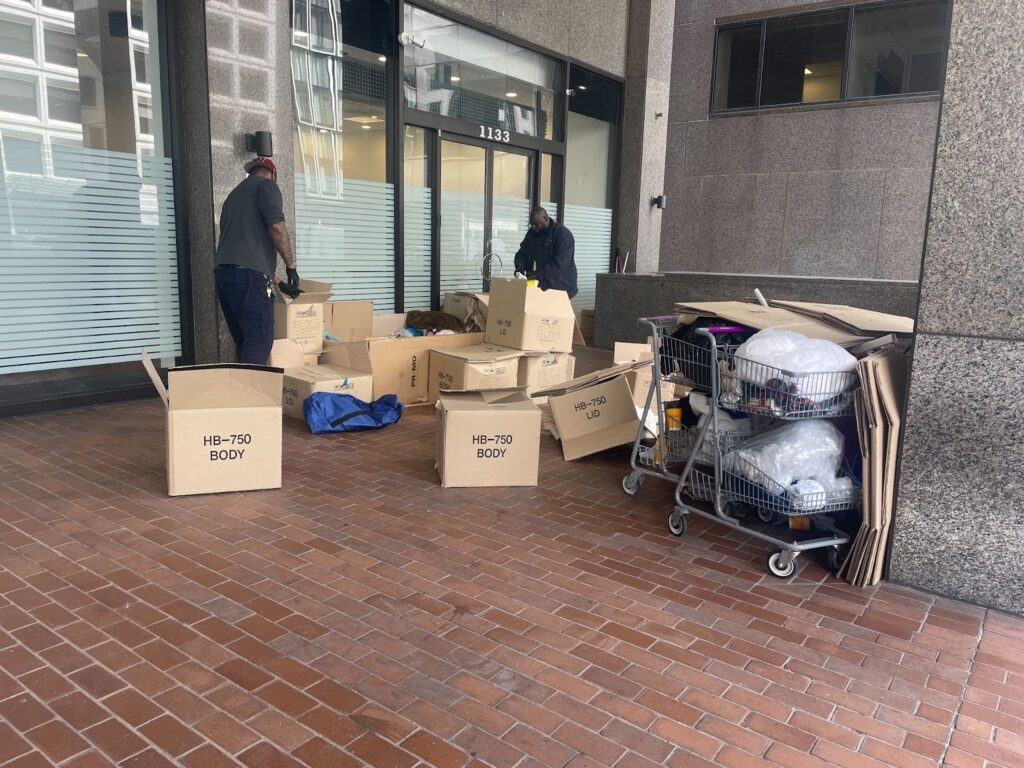Representatives of The Way Home campaign delivered clear buckets of plastic army men to District council members in their John A. Wilson Building offices on Thursday, October 1. Each toy represented a homeless veteran living in the District. The Way Home will return to remove army men from each buckets every month equal to the number of homeless veterans that have been successfully housed. By the end of this year, organizers hope for the buckets to be empty.
The Way Home, comprised of partners from various D.C. organizations as well as cabinet-level officials, has a stated goal to end chronic homelessness in Washington by 2017. That means housing everyone who “has been homeless repeatedly, or for years, and struggles with a chronic health condition.” By targeting a specific subset of the chronically homeless, The campaign hopes to provide a model for how to end chronic homelessness in the District at large.
“We’re just super excited to see that this is possible, and I think it shows that if we work together we can eliminate chronic, and then family, and then youth homelessness,” said Jill Carmichael, U.S. Director at National Community Church and a leader of The Way Home campaign. “It’s just a stepping stone to ending all of homelessness.”

Volunteers for The Way Home campaign discuss strategy before delivering buckets of army men representing the city’s homeless veterans to DC councilmembers. | Photo by Olivia Aldridge.
This effort’s success would affirm the District Interagency Council on Homelessness’ (ICH) Homeward DC 5-year plan to end homelessness, as well as Mayor Bowser’s proposed $18.7 million toward the initiative for FY 2016. The Way Home has urged the D.C. Council to invest $5.1 million more so that they can achieve their 2017 goal of ending chronic homelessness.
Over the past 23 months, The Community Partnership for the Prevention of Homelessness has tracked homeless veterans with 49 partner agencies through a Coordinated Entry system. Participating organizations are trained to provide a common assessment of homeless individuals that make contact with the organization using D.C.’s Homeless Management Information System. Based on the assessment, individuals deemed to have the highest vulnerability to injury or death are prioritized for permanent supportive housing solutions, including 30-35 percent of assessed veterans.
According to counts with this methodology, 354 veterans were in need of housing at the end of July, down from 757 in January. By the end of August, 284 were in need. To represent this decrease, each councilmember was asked to count out and remove 70 army men from their bucket at the distribution event.

Ward 5 Councilman Kenyan McDuffie receives his bucket. | Photo by Olivia Aldridge
“We’re really confident, because we know that we have a list of who these 284 are,” said Jesse Rabinowitz, Advocacy Specialist at Miriam’s Kitchen and a leader for The Way Home campaign.
The effort to find permanent supportive housing for the most vulnerable individuals is in line with the Housing First method, which operates under the philosophy that homeless individuals should be housed before being forced to pursue other goals, such as sobriety or treatment for mental health issues.
At the distribution event, Rabinowitz shared the story of one such individual, a Vietnam War veteran named Andrew. Before Pathways to Housing helped him find housing through the Housing First approach, Andrew spent 40 years sleeping on park benches in the District. Now housed, Andrew has finally received the help from his mental health provider that he has needed. According to Rabinowitz, Andrew and other recently housed veterans will accompany The Way Home to the Wilson building each month to share their stories and, hopefully, watch the buckets be depleted.

Ward 6 Councilman Charles Allen poses with The Way Home campaign volunteers after receiving his bucket and removing 70 army men (representative of the 70 veterans who were housed in August). | Photo by Olivia Aldridge
Knowing these individuals’ names and backgrounds, the ICH and The Way Home understand that there is no one-size-fits-all solution to housing for a diverse homeless population. To help represent this diversity,
The Way Home recognized homeless female veterans as well. Because female toy soldiers are not commercially manufactured, The Way Home used a 3D printer to produce several female soldiers for each bucket. White instead of green, they stand out.
If the goal to end veteran homelessness is met by the end of 2015, then The Way Home will move on to chronic homelessness by 2017 and then all homelessness by 2020. Success to the ICH would mean that homelessness in the District is “rare, brief (that those who do become homeless are housed within 60 days), and non-recurring.”

Photo by Olivia Aldridge







